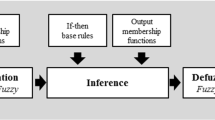Abstract
The purpose of this paper is to propose a model for assessing the hazard system based on the failure structure of aircraft wing. The model considers reliability maintenance and repair factors. Failure Mode and Effect Analysis (FMEA) is one of the well-known methods of quality management being used for continuous improvement in product or process plans. One serious issue of FMEA is the definition of the risk priorities of failure modes. This paper proposes an analytical method based on failure modes and failure analysis in criticality and suggests a fuzzy evaluation method for evaluating the risk level of the wing of aircraft. The analytical technique includes qualitatively analyzing the operation, failure modes, failure cause, failure rate, and severity through FMEA and quantitatively assessing the safety by using the fuzzy evaluation method. Fuzzy logic and Genetic Algorithms are integrated using a risk-cost model based on FMEA and comparisons with Simulated Annealing algorithms.





Similar content being viewed by others
References
ARP 926 (1967) Design analysis procedures for failure modes, effects and criticality analysis (FMECA). Aerospace Recommended Practice, Society of Automotive Engineers, Detroit, USA
Belu Nadia, Ionescu Laurenţiu (2014) Application of fuzzy logic with genetic algorithms to FMEA method. ZESZYTY NAUKOWE POLITECHNIKI POZNAŃSKIEJ, Organizacja i Zarządzanie, Nr 62:5–20
Černý V (1985) Thermodynamical approach to the traveling salesman problem: an efficient simulation algorithm. J Optim Theory Appl 45(1):41–51
Chin K-S, Wang Y-M, Poon GKK, Yang J-B (2009) Failure mode and effects analysis by data envelopment analysis. Decis Support Syst 48(1):246–256
Dyer MK, Little DG, Hoard EG, Taylor EG, Campbell R (1972) Applicability of NASA contract quality management and failure mode effect analysis procedures to the USGS Outer Continental Shelf oil and gas lease management program
Ebeling CE (2004) An introduction to reliability and maintainability engineering. Tata McGraw-Hill Education, New Delhi
Fadlovich E (2007) Performing failure mode and effect analysis. Embed Technol 11–17
Failure Mode Effects Analysis (FMEA). ASQ. http://www.asq.org/learn-about-quality/process-analysis-tools/overview/fmea.html. Accessed 15 Feb 2012
Franklin BD, Shebl NA, Barber N (2012) Failure mode and effects analysis: too little for too much? BMJ Qual Saf 21(7):607–611
Gilchrist W (1993) Modelling failure modes and effects analysis. Int J Qual Reliab Manag 10(5):16–23
Jaganathan P, Karthikeyan T (2014) An evolving approach on efficient web crawler using fuzzy genetic algorithm. Int J Sci Res (IJSR) 3(10):156–169
Jee TL, Tay KM, Lim CP (2015) A new two-stage fuzzy inference system-based approach to prioritize failures in failure mode and effect analysis. IEEE Trans Reliab 64(3):869–877
Kerk YW, Tay KM, Lim CP (2017) An analytical interval fuzzy inference system for risk evaluation and prioritization in failure mode and effect analysis. IEEE Syst J 11(3):1589–1600
Kirkpatrick S, Gelatt CD, Vecchi MP (1983) Optimization by simulated annealing. Science (80-.) 220(4598):671–680
Kumar M, Kumar S, Dev DK (2017) Fuzzy modeling to calculate component failure criticality index for forging industry. Int J Eng Technol Manag Appl Sci 5(1):89–95
Mariajayaprakash A, Senthilvelan T, Gnanadass R (2015) Optimization of process parameters through fuzzy logic and genetic algorithm—a case study in a process industry. Appl Soft Comput 30:94–103
Metropolis N, Rosenbluth AW, Rosenbluth MN, Teller AH, Teller E (1953) Equation of state calculations by fast computing machines. J Chem Phys 21(6):1087–1092
MIL-P-1629—Procedures for performing a failure mode effect and critical analysis, United States Department of Defense (9 November 1949)
MIL-STD-882 E SYSTEM SAFETY. http://www.everyspec.com/MIL-STD/MIL-STD-0800-0899/MIL-STD-882E_41682/. Accessed 4 Jan 2017
Mishra BSP, Dehuri S, Kim E, Wang G-N (2016) Techniques and environments for big data analysis: parallel, cloud, and grid computing. Springer, Basel
Neal RA (1962) Modes of failure analysis summary for the Nerva B-2 reactor. Westinghouse Electric Corporation Astronuclear Laboratory. WANL–TNR–042. http://hdl.handle.net/2060/19760069385 (PDF). Accessed date 13 Mar 2010
Potts HWW, Anderson JE, Colligan L, Leach P, Davis S, Berman J (2014) Assessing the validity of prospective hazard analysis methods: a comparison of two techniques. BMC Health Serv Res 14(1):41
Robert D et al (1963) State of the art reliability estimate of Saturn V propulsion systems. General Electric Company. RM63TMP–22. http://hdl.handle.net/2060/19930075105 (PDF). Accessed date 13 Mar 2010
SAE Standard (2002) SAE J1739: potential failure mode and effects analysis in design (design FMEA) and potential failure mode and effects analysis in manufacturing and assembly processes (process FMEA) and effects analysis for machinery (machinery FMEA). Warrendale, PA: SAE. http://standards.sae.org/j1739_200208/
Selvick JT, Aven T (2011) A framework for reliability and risk centered maintenance. Reliab Eng Syst Saf 96(2):324–331
Sperber WH, Stier RF (2009) Happy 50th birthday to HACCP: retrospective and prospective. Food Saf Mag 42:44–46
United States Department of Defense, MIL-STD-1629A—Military Standard Procedures for Performing a Failure Mode, Effects and Criticality Analysis, November 1980. ‘System Reliability Center PDF Directory’ at: http://src.alionscience.com/pdf/MIL-STD-1629RevA.pdf
Vijayarani S, Vinupriya M (2015) An efficient algorithm for facial image classification. Int J Signal Process Image Process Pattern Recognit 8(11):121–134
Wang Y-M, Chin K-S, Poon GKK, Yang J-B (2009) Risk evaluation in failure mode and effects analysis using fuzzy weighted geometric mean. Expert Syst Appl 36(2):1195–1207
Zadeh LA (1999) Fuzzy sets as a basis for a theory of possibility. Fuzzy Sets Syst 100:9–34
Funding
This study was not funded.
Author information
Authors and Affiliations
Corresponding author
Ethics declarations
Conflict of interest
The authors declare that they have no conflict of interests.
Human and animals rights
This article does not contain any studies with human participants or animals performed by any of the authors.
Additional information
Communicated by V. Loia.
Publisher's Note
Springer Nature remains neutral with regard to jurisdictional claims in published maps and institutional affiliations.
Rights and permissions
About this article
Cite this article
Gholizadeh, H., Javadian, N. & Fazlollahtabar, H. An integrated fuzzy-genetic failure mode and effect analysis for aircraft wing reliability. Soft Comput 24, 13401–13412 (2020). https://doi.org/10.1007/s00500-020-04757-3
Published:
Issue Date:
DOI: https://doi.org/10.1007/s00500-020-04757-3




